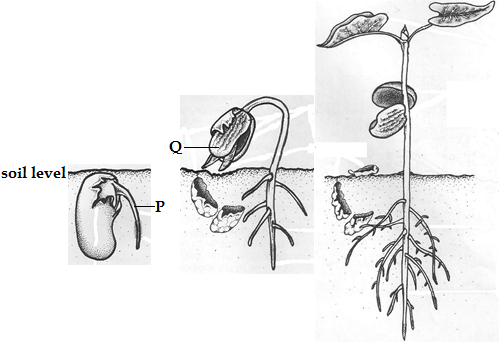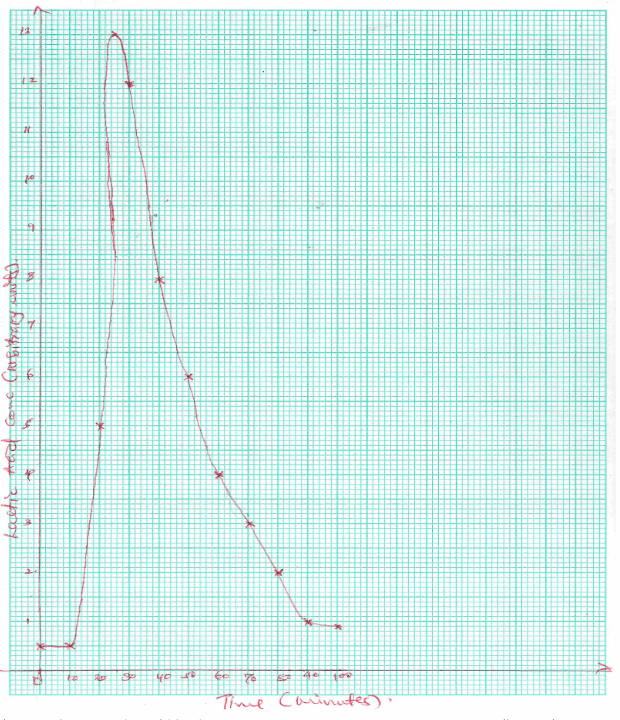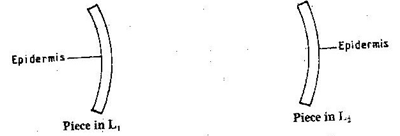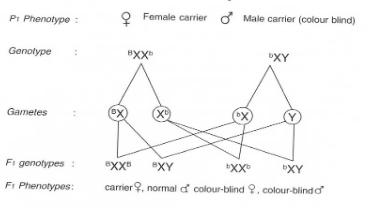INSTRUCTIONS TO CANDIDATES
- This paper consist of TWO sections; A and B.
- Answer all the questions in the section A.
- In section B answer Question 6(compulsory) and either question 7 or 8
- The diagram below represents human foetus in a uterus.
- Name the part labeled S. (1 mark)
-
- Name the types of blood vessels found in the structure labeled Q. (2marks)
- State the differences in composition of blood found in the vessels named in (b) (i) above. (2marks)
- Name two features that enable the structure labeled P carry out its function. (2marks)
- State the role of the part labeled R. (1mark)
-
- Explain what happens to excess amino- acids in the liver of humans. (3 marks)
- Which portions of the human nephron are only found in the cortex? (3 marks)
-
- What would happen if a person produced less ant -diuretic hormone? (1 mark)
- What term is given to the condition described in (c) (i) above (1 mark)
- A freshly obtained dandelion stem measuring 5 cm long was split lengthwise to obtain two similar pieces. The pieces were placed in solutions of different concentrations in Petri dishes for 20 minutes. The appearance after 20 minutes is as shown
- Account for the appearance of the pieces in solutions L1 and L2. (6 marks)
- State the significance of the biological process involved in the experiment. (2 marks)
- The diagrams below illustrate germination in Phaseolus vulgaris. Study the diagrams and answer the questions that follow

- Identify the parts labeled P and Q (2 marks)
-
- Using observable features identify the taxonomic class of Phaseolus vulgaris (1 mark)
- Give two reasons for your answer in (i) above (2 marks)
-
- What type of germination is this? (1 mark)
- Explain how the type of germination in (i) above occurs (2 marks)
-
- Colour blindness is rare in women. However when a woman has normal colour vision but is a carrier for this trait marries a colour blind man, a colour blind daughter may be born to them. Show how this is possible.
(4 marks) - Give two examples of disorders caused by mutant gene located in the chromosomes. (2 marks)
- What do you understand by the term linked genes (2marks)
- Colour blindness is rare in women. However when a woman has normal colour vision but is a carrier for this trait marries a colour blind man, a colour blind daughter may be born to them. Show how this is possible.
SECTION B (40 MKS)
Answer questions 6 (compulsory) and either questions 7 or 8
- In an experiment to determine the effect of exercise on the concentration of lactic acid in blood, the following data was obtained. Study the data and use it to answer the questions that follow. The lactic acid concentration was measured before, during and after the exercise.
Time minutes 0 10 20 25 30 40 50 60 70 80 90 100 Lactic acid conc. (arbitrary units) 0.5 0.5 5 13 12 8 6 4 3 2 1 0.9 - Using a suitable scale, plot a graph of the concentration of lactic acid against time. (6 marks)
- From the graph you have drawn determine;
- The period of exercise. Explain. (2marks)
- The time when oxygen debt occurred. Explain. (2marks)
- The duration it took to pay back the oxygen debt. Explain. (2marks).
- On the same set of axes plot a hypothetical curve for oxygen intake during the experiment period of 90 minutes. (2marks)
- Why does lactic acid level usually continue to rise in the blood after exercise ceases. (2marks)
- Suggest the two importance of anaerobic respiration to animals. (2marks)
- What is oxygen debt? (2marks)
- Describe the route taken by water from the soil up to the evaporating surface of a plant. (20 marks)
- Explain how the various abiotic factors may affect plants. (20 marks)

MARKING SCHEME
- The diagram below represents human foetus in a uterus.
- Name the part labeled S.
- chorion (1 mark)
-
- Name the types of blood vessels found in the structure labeled Q. (2marks)
- vein ,artery
- State the differences in composition of blood found in the vessels named in (b)(i) above. (2 marks)
artery
glucose, amino acids, vitamins, mineral salts, oxygen,vein
Carbon (IV) Oxide,urea
- Name the types of blood vessels found in the structure labeled Q. (2marks)
- Name two features that enable the structure labeled P carry out its function. (2marks)
- Semi permeability; for selective exchange of substances;
- Its ductless for hormonal secretion
- State the role of the part labeled R. (1mark)
- Shock absorber
- Name the part labeled S.
-
- Explain what happens to excess amino- acids in the liver of humans. (3 marks)
- They are detoxified to harmless forms
- Which portions of the human nephron are only found in the cortex? (3 marks)
- glomerulus,Bowman’s capsule and proximal convoluted tubule
-
- What would happen if a person produced less ant -diuretic hormone?(1 mark)
- Will produce a lot of dilute urine
- What term is given to the condition described in (c) (i) above (1 mark)
- Diabetes inspiduS
- What would happen if a person produced less ant -diuretic hormone?(1 mark)
- Explain what happens to excess amino- acids in the liver of humans. (3 marks)
- A freshly obtained dandelion stem measuring 5 cm long was split lengthwise to obtain twosimilar pieces. The pieces were placed in solutions of different concentrations in Petri dishes for 20 minutes. The appearance after 20 minutes is as shown
- Account for the appearance of the pieces in solutions L1 and L2. ( 6 marks)
- L1 placed in hypertonic solution; lost water by osmosis; flabby
- L2 Placed in hypotonic solution; absorbed by osmosis; turgid
- State the significance of the biological process involved in the experiment. ( 2 marks)
- Osmoregulation; support; movement of water from cell to cell; feeding in insectivorous plants; absorption of water by root hair cells
- Account for the appearance of the pieces in solutions L1 and L2. ( 6 marks)
- The diagrams below illustrate germination in Phaseolus vulgaris. Study the diagrams and answer the questions that follow
- Identify the parts labeled P and Q (2 marks)
- P……Radicle………………………………………………………………………………………….
- Q ...... cotyledon………………………………………………………………………………………….
-
- Using observable features identify the taxonomic class of Phaseolus vulgaris (1 mark
- dicotyledonae
- Give two reasons for your answer in (i) above (2 marks)
- Tap root, network veined, two cotyledons
- Using observable features identify the taxonomic class of Phaseolus vulgaris (1 mark
-
- What type of germination is this? (1 mark)
- Epigealgermation
- Explain how the type of germination in (i) above occurs (2 marks)
- The hypocotyls curves and pushes upwards through the soil protecting the delicate shoot tip; it then elongates carrying with it the two cotyledons
- What type of germination is this? (1 mark)
- Identify the parts labeled P and Q (2 marks)
-
- Colour blindness is rare in women. However when a woman has normal colour vision but is a carrier for this trait marries a colour blind man, a colour blind daughter may be born to them. Show how this is possible
(4 Marks) - Give two examples of disorders caused by mutant gene located in the chromosomes. (2 marks)
- Albinism
- Sickle cell
- Anaemia
- What do you understand by the term linked genes (2marks)
- These are genes that are located in the same chromosome and therefore inherited together
- Colour blindness is rare in women. However when a woman has normal colour vision but is a carrier for this trait marries a colour blind man, a colour blind daughter may be born to them. Show how this is possible
- In an experiment to determine the effect of exercise on the concentration of lactic acid in blood, the following data was obtained. Study the data and use it to answer the questions that follow. The lactic acid concentration was measured before, during and after the exercise.
Time minutes 0 10 20 25 30 40 50 60 70 80 90 100 Lactic acid conc. (arbitrary units) 0.5 0.5 5 13 12 8 6 4 3 2 1 0.9 - Using a suitable scale, plot a graph of the concentration of lactic acid against time. (6 marks)

- From the graph you have drawn determine;
- The period of exercise. Explain. (2marks)
- 10-15 minutes; period of rapid increase in lactic acid concentration
- The time when oxygen debt occurred. Explain. (2marks)
- 10-20 seconds; period when lactic acid level starts to increase
- The duration it took to pay back the oxygen debt. Explain. (2marks).
- 75 minutes; this is the time lactic acid took to decrease from the highest level to normal
- The period of exercise. Explain. (2marks)
- On the same set of axes plot a hypothetical curve for oxygen intake during the experiment period of 90 minutes. (2marks)
- Why does lactic acid level usually continue to rise in the blood after exercise ceases. (2marks)
- It’s still diffusing out of the muscles, where it was made a few minutes earlier
- Suggest the two importance of anaerobic respiration to animals. (2marks)
- allows for energy production even in cases of oxygen deficiency; thus enables animals to survive actively even in areas of low oxygen;
- What is oxygen debt? (2marks)
- Is the amount of oxygen required to get rid of lactic acid; accumulated due to anaerobic respiration.
- Using a suitable scale, plot a graph of the concentration of lactic acid against time. (6 marks)
- Describe the route taken by water from the soil up to the evaporating surface of a plant. (20 marks)
Water is drawn into the root hair cells by osmosis; due to the presence of dissolved substances in the cell sap of root hairs, the concentration of cell sap is greater than that of the surrounding solution in the soil/concentration gradient; this exerts a higher osmotic pressure, thus drawing the water molecules across the cell wall and cell membrane into the root hair cells; more water drawn into the root hair cells dilutes the cell sap; making it less concentrated than that in the adjacent cortex cell of the root; due to osmotic gradient, water moves from the adjacent cells to the next by osmosis; until it enters the xylem vessels located in the center of the root; the xylem vessels of the root then conduct the water up into the xylem vessels in the stem into the leaves; there is a force in the roots which pushes water up the stem; this force is known as root pressure; and can be considerably high in some plants; energy from the endodermal cells of the root is responsible for driving this force; in the xylem vessels, water would rise up by capillarity; to some extent because the vessels are narrower and there is a high attractive force between the water molecules and the cell walls; the cohesive; and adhesive forces are important in the maintenance of a continuous and uninterrupted water column in the xylem vessels up the tree to the leaves; water vaporizes from the spongy mesophyll cells; their cell sap becomes concentrated than the adjacent cells. This increases the osmotic pressure of the spongy mesophyll cells; as a result of this, water flows into the cell from other surrounding cell, which in turn takes in water from xylem vessels within the leaf veins; this creates a pull/suction force that pulls a stream of water from xylem vessels in the stem and roots. This force, known as transpiration pull; helps in maintaining a continuous column of water from the roots to the leaves; water flows from the midrib into leaf veins from where it enters leaf cells; from the mesophyll cells, it enters the airspaces; then the substomatal air chambers; from where it evaporates through the stomata; to the atmosphere; (Max. 20 marks) - Explain how the various abiotic factors may affect plants. (20 marks)
Temperature; affects soil formation and distribution of plants; affect transpiration rate as high temperatures lead to high rates of transpiration; It also affects the rate of photosynthesis with the direct influence on enzyme activity; Light intensity; affects the rate of photosynthesis; Wind; increase the transpiration rates; affects dispersal of seeds and fruits; agents of pollination; affect distribution in terms of wind storms/breakages; Atmospheric pressure; high atmospheric pressure leads to low rates of transpiration; high oxygen and carbon (IV) oxide concentration; high photosynthetic rates; while low atmospheric pressure leads to high transpiration rates; less concentration of oxygen and carbon (IV) oxide; leading to low rates of photosynthesis; Water/Rainfall; forms a raw material for photosynthesis; helps in support in plant tissues; affects distribution of plants; Humidity; low humidity leads to high transpiration rates; while high humidity leads to low rates of transpiration; pH; affects distribution of plants; some grow in acidic soils; others in alkaline soils; Edaphic/soil factors; affects plant distribution; in terms of being sources of water and mineral salts; provide a substratum for anchorage of plants;
(Max. 20 marks)
Download Biology Paper 2 Questions and Answers - Pavement Pre-Mock Exams 2021/2022.
Tap Here to Download for 50/-
Get on WhatsApp for 50/-
Why download?
- ✔ To read offline at any time.
- ✔ To Print at your convenience
- ✔ Share Easily with Friends / Students




